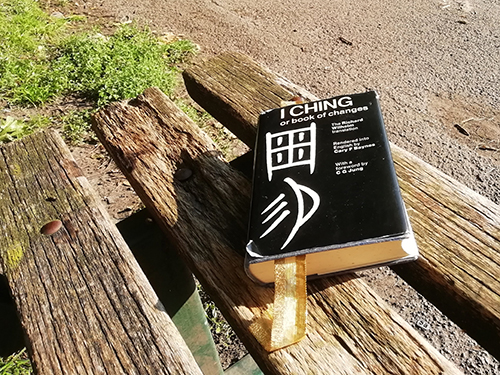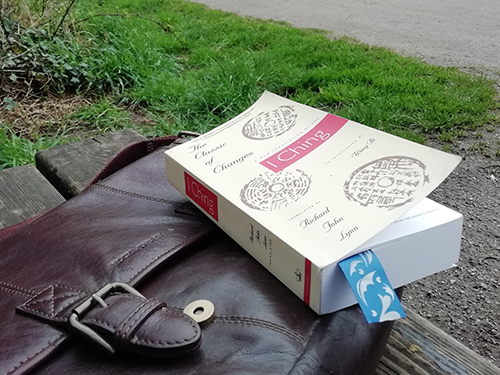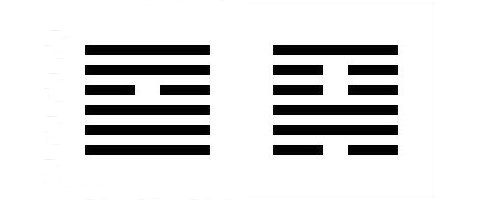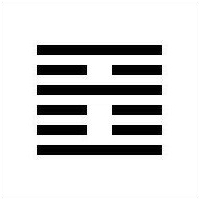The images of the Book of Changes are of such sort that one can act in accordance with the changes and know reality
– Ta Chuan
Invisible threads are the strongest ties
– Nietzsche
People like the I Ching for different reasons. It’s validating and comforting they say, like talking with a wise friend. It’s fascinating others say, which it is. Another reason is aesthetic curiosity. What is this book, what do these symbols mean, how do we understand the words?
 |
 |
The I Ching is partly Confucian and partly Taoist. The first concerns humanism, the second naturalism and transcendence. This reflects in the structure of the book. The top two lines of a hexagram correspond to spirit, the centre two are humanity, and the lower lines represent earth. It’s a trinity which reflects in many traditions summarised as spirit, matter, and consciousness.
At a deeper level there’s no distinction between Confucianism and Taoism as a pursuit of meaning or wisdom. Theosophical teachings have the same idea. Their supposition is, all religions are essentially the same. This is not entirely true, because they vary a great deal, with the fundamental difference of either belief or enquiry. The first has a superstitious logic, while the second is an investigation of consciousness. The subject occurs in the book Waking Up by Sam Harris. You don’t need a tradition he says, just sit and meditate. Mindfulness is the idea, essentially the same as Buddhist Vipassana.
I remember buying my first I Ching many years ago. I discussed it with a person one might describe as a hippy. There were a few of them around. Religious Studies people with alternative cultural interests, while I was studying English and Psychology. Ah yes he said, the I Ching. There’s a purity to it compared to other systems. He meant abstraction, before ideas are embellished and diluted. Hellmut Wilhelm (son of Richard) says the same in Heaven, Earth and Man in the Book of Changes. The book is:
An attempt to come nearer to the same universal problems whose reflection in other cultures has led to the insights expressed in their various mythologies; in particular, it is an attempt to come near a solution for the ever present problem of duration and change, of being and becoming…In this world of unordered changes, the tensions do not build up myths, but primal images as centres of gravity around which order may be brought into chaos.
I often mention the difference between the Meaning and Principle School (yili) and Image and Number School (xianshu). The I Ching comes alive when you don’t read Wilhelm or any other book but work directly with trigrams and lines (xianshu). The lower hexagram trigram is self, the upper is other and the relationship between the two, conditioned with their energies, reveals the situation. It’s like a scientific formula you understand for yourself without the need for a professor.
The great value of the Meaning and Principle approach is philosophy. It means you work with ideas not confined to hexagrams, not only when you read the ancient book. The Ta Chuan, part of the Confucian Ten Wings, explains the practice: “the superior man contemplates these images in times of rest and meditates on the judgments. When he undertakes something, he contemplates the changes and ponders on the oracles.” Study and reflect on the book at leisure then when you consult it, you have a good understanding.
Sun Tsu’s Art of War offers similar advice. In times of peace prepare for war, which means training. When at war be calm and peaceful, because that’s an effective way of fighting. You can do that if you’ve been training and have the necessary skills. You can’t if you are unprepared. The circular yin and yang symbol shows black within white, white within black. The I Ching advises watch for evil or negativity before it gets too strong, and never entirely relax.
It is possible to contemplate the I Ching according to the Image and Number School but it’s less immediate. You can reflect on trigram energies in relation to weather, nature, people, or daily mood. Your manager is ruling and unpredictable, wanting results and goals. Another manager in another job, because you had enough of it, is subtle and indirect. You don’t need pushing around you think; just respect my ability. The first manager was thundery yang (trigram Chen) and the second is softly influential yin (trigram Sun). In a book called Awakening the Tao, Liu I-ming contemplates these energies as opposites which need to blend:
Thunder is fierce, intense, and strong; wind is gradual, far-reaching, and soft. When wind and thunder combine, then there is soft gentleness in the midst of hard intensity, and there is hard intensity in the midst of soft gentleness. Hardness and softness complement each other.
The notion that all life is connected is scientifically meaningful. Einstein pursued a unified field theory, which is the structure of the I Ching. There’s a Theosophical book describing unity as The Web of the Universe (E.L. Gardner). In another book, The Stanzas of Dzyan it says “Father and mother spin a web” which means spirit and matter: the first two hexagrams.
There was a moment when I’d been studying the five phases (elements) and walked beside a river. My perception was different. I didn’t see water, earth, trees and sky: I saw the phases. As a unified field, everything with an atomic structure, the meaningful difference was not obvious water in relation to obvious earth but fluid flow compared to static mass. “Substance in China” Wilhelm explains “is rather conceived as a state of energy” (Lectures on the I Ching).
The Meaning and Principle approach encompasses psychology and philosophy, reflected in I Ching structure. Trigrams correlate with humanity but they are natural not human forces: Heaven, Earth, Water, Fire, Wind, Thunder, Mountain and Lake. Hexagrams depict human situations and with this approach you might understand why the first manager was annoying but constitutionally inclined. They were bossed around, so it’s the only method they know. Hexagram 18 Work On What Has Been Spoiled encourages you to understand a broken condition. Or their current life is such that they are not at ease. The Taming Power of the Small, hexagram 9, might suggest small balancing changes. Hexagram 9 is wind over heaven, hexagram 18 is wind under mountain.

It is interesting contemplating trigrams and the five phases but as a more subtle process. A practice for Taoists perhaps, living on a mountain, avoiding the encounter with society. Liu I-ming’s Taoist I Ching, translated by Thomas Cleary, is part of what is called Complete Reality Taoism where “Its practitioners are largely members of ordinary society, from many walks of life, who combine their worldly duties with mystical practice.” The Fourth Way of Gurdjieff, partly derived from Sufism, teaches the same approach.
The hexagram Biting Through is an interesting study which is not romantic. Hexagrams apply at different levels, but here the starting point is social. We encounter an unpleasant person and need advice. The yang fourth line is an obstacle (person) which in extreme form means criminality and slander:
This is true in all situations. Whenever unity cannot be established, the obstruction is due to a talebearer and traitor who is interfering and blocking the way. To prevent permanent injury, vigorous measures must be taken at once. Deliberate obstruction of this sort does not vanish of its own accord.

The question is, what vigorous measures should we use and for what situation. A violent reaction is not advisable, but meekness isn’t either. This concerns punishment and removal from society if they are dangerous. At a mundane level you might have to deal with someone diplomatically (indirectly) if you can’t avoid them. Although some people are intractably unreasonable and impervious to change, best removed from your life.
The philosophy of Meaning and Principle is endless, as theory interacts with changing experience. The Ta Chuan advises you practice related contemplation, and there is no reason why this cannot include trigram and five phase energies, or Image and Number methodology. The Taoist I Ching suggests you read two hexagrams every day, morning and night. My practice is correlating the I Ching with other studies. The book is distinctive as a system of abstract symbols. But it applies in relation to circumstance, psyche, and society.
I will conclude with the subject of Tao and what it means for the I Ching. There’s a well known teaching story where a village is suffering from drought. They ask a rain maker, who lives in the mountains, to solve the problem. He asks for a hut outside the village where he won’t be disturbed. The villagers become worried. They don’t see him for two days, and there is no rain. On the third day it rains. They run towards the hut, grateful and excited, and ask him what he did. I didn’t do anything he says. The village was unbalanced and not aligned with Tao. I sat and meditated until balance was restored. Then it rained.
We read “The Tao that can be told is not the real Tao” in the Tao Te Ching. It’s not a belief, or definable in words. Although with Theosophical ideas it is possible. We have, they say, seven principles as a human being which are higher and lower: a physical body, energetic, emotional, lower mental, higher mental, intuitional and spiritual.
Tao means alignment with the higher principles or higher self. You look down from above and see life more clearly below. Hexagrams depict the energy of a moment, how it is balanced or unbalanced, aligned or not.
I write like this is a magazine column. With research, references, and a lot of time. If you like it, perhaps you would support me.
